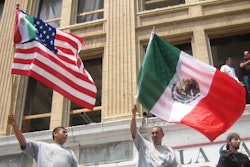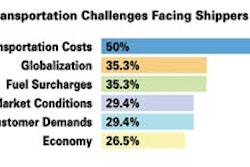The Chinese year of the rat — 2008 — marks two milestones in the history of the North American Free Trade Agreement, or NAFTA: record trade levels under the agreement and an end to remaining trade barriers, including those on U.S. corn and Mexican sugar. Full implementation of NAFTA went into effect this year on January 1.
NAFTA has been wildly successful, not just increasing trade among Canada, the United States and Mexico, but also spurring the creation of free trade agreements (FTAs) across the globe. Since its inception the world has seen the rise of other FTAs, including the Central America-Dominican Republic-United States Free Trade Agreement (CAFTA-DR), signed on August 5, 2004, as well as bilateral agreements between the United States and such countries as Chile and Israel. Other FTAs, including the ASEAN Free Trade Area, Mercosur and the European Union, have skyrocketed in importance since NAFTA.
WIIFM — What's in It for Me?
This increasing use of FTAs, and NAFTA in particular, boils down to two simple realities for Canadian, Mexican and U.S. companies — NAFTA can save you money, and it's here to stay.
NAFTA requires knowledge of country of origin for goods, which in turn requires visibility into the items that comprise a finished good. Knowing preferential duty rates for various items can help a company determine lowest-cost sourcing — for example, whether it's better to source from China or Mexico.
Even companies that may not be manufacturing in the NAFTA region today may want to keep abreast of preferential duty rates to determine whether they should manufacture and source goods in Canada, Mexico or the United States in the future. With the decline of the dollar, increases in fuel costs and the increasing likelihood of supply chain bottlenecks, manufacturing within NAFTA is looking more attractive than ever before. In the 2007 study "Five Ways to Increase the Business Value of Trade Compliance," Aberdeen Group found that if five U.S. importers shifted their sourcing mix across existing suppliers to maximize trade agreements, they could potentially save more than $150 million.
Yet companies need to do their homework before taking advantage of NAFTA. An automobile, for example, has thousands of parts. Companies need a qualification process to determine country of origin for such a product. Because there are many rules and regulations around the answer, determining country of origin for even a single product with many parts is a complex procedure, which is why most companies that want to take advantage of NAFTA procure software that automates the process. Larger companies that source from around the globe and produce thousands of products face even greater challenges.
Technology can help companies manage a variety of NAFTA issues, from overseeing suppliers and FTA information, to qualifying finished goods, to developing a master data repository of product information and trade transactions. Furthermore, using a solution to automate a NAFTA qualification process allows companies to take advantage of other FTAs and bilateral agreements, since all the product information resides in one place.
A Measure of Success
NAFTA's results speak for themselves: the FTA created the world's largest trade bloc. According to the office of the United States Trade Representative (USTR), from 1993 to 2005, trade among the NAFTA nations climbed 173 percent, from $297 billion to $810 billion. U.S. merchandise exports to NAFTA partners grew more rapidly — at 133 percent — than our exports to the rest of the world, at 77 percent. Canada and Mexico are now our first and second largest markets, accounting for 36 percent of our export growth to the world.
Last October, NAFTA trade reached record levels, 11.1 percent higher than in October 2006, reaching $74.2 billion, the highest monthly level ever recorded by the Bureau of Transportation Statistics, part of the U.S. Department of Transportation. The previous monthly high for surface trade was $69.8 billion in March 2007. October 2007 topped that by 6.4 percent.
Since its inception on January 1, 1994, NAFTA has increased the gross domestic products of the United States, Canada and Mexico and their trade. Imports in October 2007 were up 100.7 percent compared to October 1997, while exports were up 72.0 percent. From 1993 to 2005, U.S. GDP grew 48 percent, Mexico's 40 percent and Canada's 49 percent, according to data from USTR. Acting Agricultural Secretary Chuck Conner described NAFTA "as one of the most successful trade agreements in our history" on January 2, 2008.
"In 1994, our combined agricultural exports to Canada and Mexico totaled $10.1 billion. They are expected to reach $28 billion in 2008. Since the agreement's implementation, two-way agricultural trade between the United States and Canada has risen from $10.4 billion to $30.4 billion. Between the United States and Mexico, this trade has risen from $5.9 billion to $24 billion," Connor said.
A Blueprint for the Future
The success of NAFTA has not been lost on the rest of the world. The European Union has expanded dramatically since its inception to compete with NAFTA, growing from six countries in 1957 (at that point the European Economic Community) to its current 27 members.
Today the European Union has virtually eliminated borders between its member countries, creating a monolithic European organization with its own currency, tariffs, standards, motto and flag. It is a single market governed by a system of laws that apply to all member states. European Union Law provides the free movement of goods — member states have removed customs barriers between themselves and introduced a common customs policy toward other countries — much as NAFTA has with the United States, Canada and Mexico (although we have yet to create our own NAFTA song and motto).
Mercosur is another FTA that has expanded partly in response to NAFTA. Originally an agreement among Brazil, Argentina, Uruguay and Paraguay, founded in 1991, the group has added Bolivia, Chile, Columbia, Ecuador and Peru as associate members. Venezuela is awaiting ratification of its member status to the group. South Americans see Mercosur as a strategic counterbalance to NAFTA and other global economic powers. Then there is the ASEAN Free Trade Area, originally comprised of six members in 1992. Today it has grown to 10 members: Brunei, Vietnam, Laos, Thailand, Indonesia, Malaysia, Philippines, Singapore, Myanmar and Cambodia. As with the European Union and Mercosur, ASEAN's goal is to increase the global competitive edge of its member countries with elimination of tariffs among member countries.
NAFTA has also encouraged the increase in bilateral agreements between nations. Today the United States has a number of bilateral agreements with other countries, including Australia, Israel, Bahrain, Chile, Columbia, Korea and Singapore. Still more are under negotiation.
The Future of NAFTA
What's next? More companies will be entering NAFTA, and companies will be expanding their use of NAFTA this year and beyond. Indeed, with increased globalization and competition, companies can't afford to not take advantage of NAFTA and other FTAs. Even small and midsize companies are beginning to take advantage of NAFTA, and, again, those numbers will increase in 2008. Aberdeen's 2007 "Global Trade Management Strategies" benchmark report finds that 48 percent of respondents plan to increase their usage of preferential trade agreements in the near future. Among larger companies, a broader range of industries are using or are planning to use NAFTA. NAFTA leaders were once large manufacturers and electronics companies. However, that segment has expanded to include an array of other industries and will continue to grow.
Yet there are two hurdles to overcome: education and automation. From an education standpoint, companies need to know how NAFTA will benefit them. In addition, they need to understand the rules and regulations surrounding NAFTA, particularly the rules of origin, which are used to determine the country of origin of a good.
Another hurdle for companies is the complexity of NAFTA and the effort needed to take advantage of it. With an end product that might have 50,000 parts, it's almost impossible to manage manually. Even starting such a project is daunting without automation given the difficulty of working on a spreadsheet with thousands of rows. Companies need to take advantage of software solutions that automate the trade agreement process, from qualification to calculating the duties, taxes and fees for shipping a final product.
More changes are on the horizon. Ten years from now NAFTA will likely be superseded by the Free Trade Agreement of the Americas, an agreement that includes the Western Hemisphere countries from Canada to Chile. The latest round of negotiations among 34 countries on this expanded FTA occurred in 2003, and initial talks started in 1994 with the Summit of the Americas.
The FTA of the Americas, otherwise known as ALCA-FTAA, will establish a common set of rights and obligations around market access, agriculture, services, investment, government procurement, intellectual property, competition policy, subsidies, antidumping, countervailing duties and dispute settlement. Countries will also be allowed to engage in bilateral agreements within the FTA.
NAFTA is a necessary steppingstone to remain competitive in the world market. Lowering supply chains costs is no longer optional in today's world — it's a must to remain in business. As trade and logistics costs continue to increase, companies must find new ways to limit costs that are within their control and use economic trends to their advantage. FTAs, and NAFTA in particular, represent an economic trend that companies can use to limit global trade costs and improve their competitive advantage. With your business' future at stake, how can you afford not to?



















